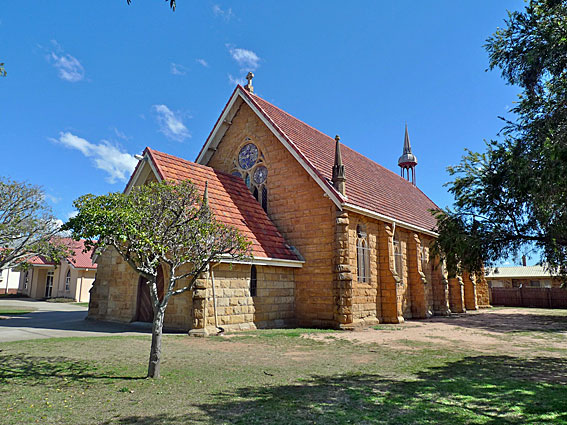
Warwick Uniting Church (formerly St Andrew's Presbyterian Church)
[Photograph by Trevor Bunning (August 2010)]

Warwick Uniting Church (formerly St Andrew's Presbyterian Church)
[Photograph by Trevor Bunning (August 2010)]
Historical and Technical Documentation by Geoffrey Cox
© OHTA 2011, 2019 (last updated October 2019)
The congregation of the Uniting Church, Warwick, incorporates those of the former Methodist Church and St Andrew's Presbyterian Church. The former Methodist Church building on the corner of Guy and Grafton Streets was removed in toto in 1997 to The Scots PGC College. The combined congregation now meets in the former St Andrew's Presbyterian Church.
The Presbyterian Church in Warwick was established in 1851, initially under the Synod of Australia (which looked to the established Church of Scotland) but it joined the 'Union' in 1864, a year after the Presbyterian Church of Queensland was formed.1 Services were held at first in the Court House, but a sawn slab and shingle church was constructed on the present site in 1858. The present church, made of local sandstone, was opened on 20 November 1870, and the stone entry porch was added in 1897. A vestry and choir room were added to the eastern end of the church in 1922. Extensive changes were made to the interior of the church in 1964-65 following a gift from the Ross family.2
It is reported that "an organ was heard in the kirk" around 1883,3 but no other details of this instrument (presumably a harmonium) have come to light. Plans for a pipe organ were announced clearly in January 1924. These included an extension to accommodate the organ, and a new pulpit designed by the architect, Mr Lange L. Powell of Brisbane:
St Andrew's Presbyterian Church - The Rev. A. Watson has received the plans of the new pipe organ and building extensions for St Andrew's Presbyterian Church. The improvements which comprise an extension of the western end of the church and a new pulpit have been designed by Mr. Powell of Brisbane. The pipe organ will cost over £1200, the money for which is in hand, and the whole work will cost between £1600 and £1800.4
The contract for the organ had been let to Whitehouse Bros of Brisbane by May 1924,5 and the dedication of the instrument took place on Sunday 28 September.6 A report of the event appeared in The Brisbane Courier two days later, including the complete specification of the organ. This had been drawn up by Mr Robert Dalley-Scarlett, who was, at that time, organist of St Andrew's Presbyterian Church in Brisbane:
The dedication service in connection with the installation of the new pipe-organ in St. Andrew's Presbyterian Church took place on Sunday. The officiating organist was Mr. Willesden RCO, A.Mus., T.C.L., L.T.C.L., of Ipswich, and there was a full choir under the conductorship of Mr. H. G. T. Williams. The Rev. Jas. Gibson, M.A., Moderator of the Presbyterian Church of Queensland, was the officiating minister supported by the Rev. A. Watson. As the service partook somewhat of a memorial character, the church honour roll was draped with the Union Jack, and the Rev. A. Watson read over the names of those who had made the supreme sacrifice in the Great War. Following this the "Dead March in Saul" was played on the organ, the congregation standing in reverent silence. The organ is installed in a specially constructed annexe at the rear of the church, and the addition is in harmony with the main church building, the manual [i.e. console] being immediately in front of the pulpit. The specifications were drawn up by Mr. R. Dalley Scarlett, L.T.C.L., F.T.C.L., L.A.B., of Brisbane, and the architect was Mr. Lange Powell, also of Brisbane. The organ was built by the well-known Brisbane firm of Messrs. Whitehouse Bros., with specifications as follows:- Great organ: Open diapason, 8ft.; dulciana, 8ft.; clarabella, 8ft.; Lieblich flute 4ft. Couplers: Swell to great, swell to great sub, swell to great super, swell to pedal, great to pedal. Swell organ: Double diapason, 16ft.; violin diapason, 8ft.; Lieblich gedact, 8ft.; echo gamba, 8ft.; voix celeste, 8ft.; tremulant. Pedal organ: Bourdon, 16ft.; bass flute, 8ft.; thumb pistons, three to swell organ, two to great organ, lever swell pedal; tubular pneumatic action throughout. The first organ recital takes place on Tuesday.7
The first organ recital, which took place on Tuesday 30 September, was given by Mr Robert Dalley-Scarlett of Brisbane. He was assisted by Mrs Lucy Kingsford, who contributed two items, and the Warwick Presbyterian Church Choir, under the leadership of Mr H.G.T. Williams.8
The final cost of the organ is recorded in the Whitehouse Bros ledger as £1,228, which included supplying the matching oak pulpit.9 It appears, therefore, that both the pulpit and the organ case were designed by the architect, Lange L. Powell, and built by Whitehouse Bros. The instrument and matching pulpit were placed centrally beneath the rose window at the front of the church.
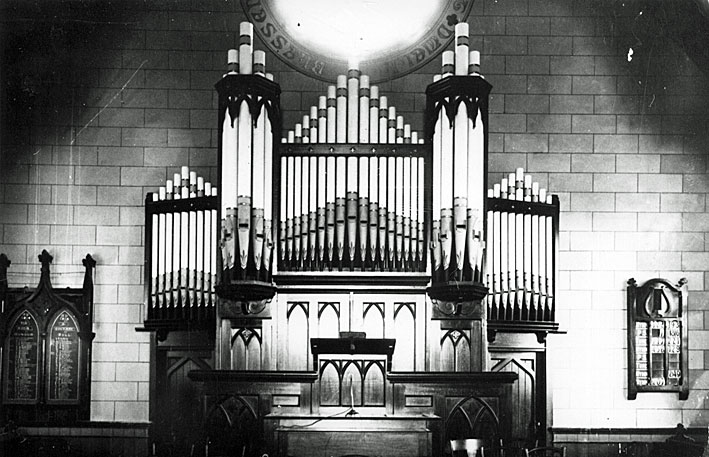
Organ casework and matching pulpit, designed by Lange Powell
[Photograph supplied by Whitehouse Bros, Brisbane, c.1974]
Tuning by Whitehouse Bros was noted in 1925 and minor repairs in 1934.10 In December 1937, the tremulant was moved and a cover box supplied, and in November 1938 two new stops (Cornopean 8ft and Labial Clarinet 8ft) were added:
| Supplying installing new cornopean 8ft Supplying installing new windchest for gemshorn & 49 lab clar pipes Boring & fitting cone pallets puffers for 12 bottom notes of clarinet |
£99.10.- £94.-.- £2.10.-11 |
As the Gemshorn was located on the Great before 1965,12 it appears that it was probably moved from the Swell in 1938 to make way for one of the added stops. Further stops were added in November 1941 (Great Diapason Phonon 8ft) and August 1952 (Great Tuba Minor 8ft), and a new tremulant was supplied in April 1944.13 Some of these additions appear to have been made without supplying new chests, as there were at least two ranks of pipes in storage (Labial Clarinet 8ft, and Flute 4ft) by the time the organ came to be enlarged and electrified in the mid 1960s.
In conjunction with the changes to the church interior, the organ was completely rebuilt, electrified and enlarged to three manuals in 1965 by Whitehouse Bros, under the consultancy of Mr Robert Boughen. The entire instrument was recessed into the alcove beneath the rose window, and covered by a wooden screen. The Diapason Phonon 8ft & Tuba Minor 8ft were removed at this time,14 and the stops that had been in storage were restored to use. The Gemshorn was transferred from the Great to the Swell. New bottom octaves were supplied for the Swell Gamba and the old Great Dulciana, the latter being moved to the Choir. The organ now uses a combination of electro-pneumatic and direct-electric action, and most of the stops on the Choir and Pedal organs are derived by extension.
Wind pressures were raised in 1999 by Ian Brown & Associates of Ballina in order to correct pitch problems.15 A Geigen Principal 4ft was added to a spare slide on the Choir Organ in 2010 by David Cahill of Warwick. For this, Cahill used pipework of unknown provenance by Alfred Palmer of London. At the same time he replaced the bottom octave of the Dulciana 8ft on the Choir Organ, again using Palmer pipework, and replacing former Laukhuff pipework dating from 1965.16
The organ was removed to storage by David Cahill in late 2019. His was to allow for corrective structural work in the organ chamber, where subsidence had occurred. The instrument is expected to be rebuilt and reinstalled with restored casework.17
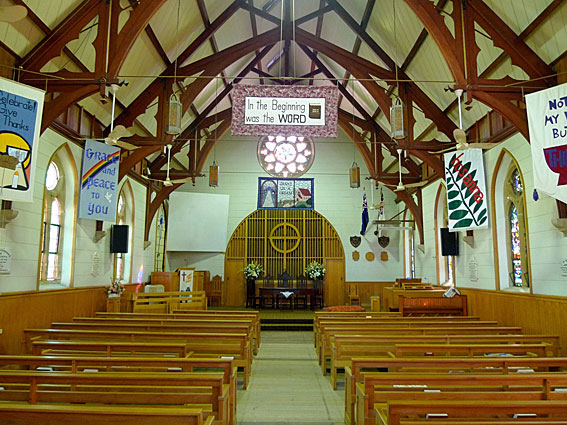
The organ located behind a screen since 1965
[Photograph by Trevor Bunning (August 2010)]
| GREAT Open Diapason Clarabella Principal Flute Twelfth Fifteenth SWELL Double Diapason Diapason Gedact Gamba Celeste Gemshorn Piccolo Mixture Cornopean Oboe CHOIR Dulciana Flute Geigen Principal Dulcet Flute Twelfth Flautina Labial Clarinet PEDAL Acoustic Bass C Bourdon Violone Bass Flute Cello Octave Flute Viole COUPLERS Great to Pedal Swell to Pedal Choir to Pedal Swell to Great Swell to Great Sub Swell to Great Super Swell Sub Swell Super Swell Unison Off Swell to Choir Choir to Great |
8 8 4 4 2-2/3 2 16 8 8 8 8 4 2 III 8 8 8 8 4 4 4 2-2/3 2 8 32 16 16 8 8 4 4 |
[Ten. C] A B A B A B C C D C D C D |
[1924] [1924] [1924, 'Lieblich Flute'] [1924] [1924 'Violin Diapason'] [1924 'Lieblich Gedact'] [1924 'Echo Gamba'] [1924 'Voix Celeste'] [before 1938, on Great until 1965] [1938] [before 1965] [1924, on Great] [2010] [1938] [1924] [1924] |
Detached draw-stop console
Electro-pneumatic and direct-electric action
Swell tremulant
Choir tremulant
5 combination pistons to each manual, and pedals
Reversible thumb piston - Swell to Great
Reversible thumb piston - Swell to Pedal
Reversible thumb piston - Great to Pedal
Reversible toe piston - Great to Pedal
Reversible toe piston - Full Organ
General cancel
Compass: 61/30
Great & Pedal combinations coupled.18
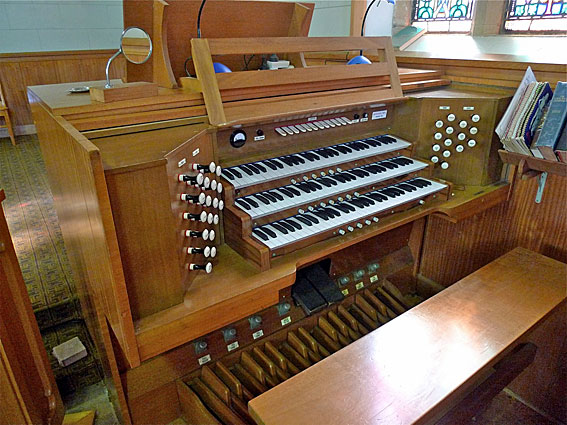
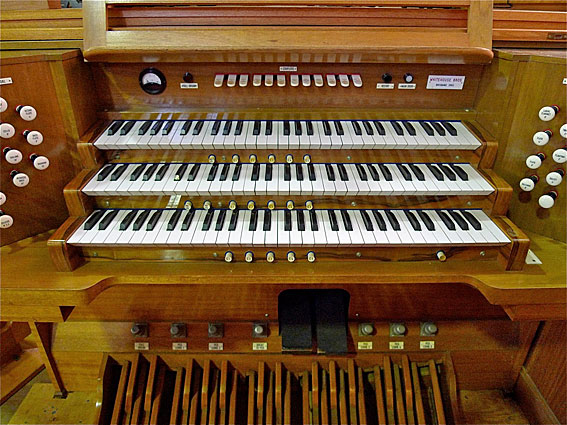
The Whitehouse console of 1965
[Photographs by Trevor Bunning (August 2010)]
_____________________________________________________________________
1 Richard Bardon, The Centenary History of the Presbyterian Church of Queensland (Brisbane: W. R. Smith & Paterson, 1949), p. 262.
2 Queensland Heritage Council, Queensland Heritage Register, location 601757.
3 Bardon, op. cit.
4 The Brisbane Courier (28 January 1924), p. 9.
5 The Brisbane Courier (29 May 1924), p. 9.
6 The Brisbane Courier (1 September 1924), p. 16.
7 The Brisbane Courier (30 September 1924), p. 8.
8 The Brisbane Courier (2 October 1924), p. 10.
9 Whitehouse Bros Ledger (1922-1940), p. 144.
10 Whitehouse Bros Ledger (1922-1940), pp. 114, 427.
11 Whitehouse Bros Ledger (1922-1940), pp. 542, 544. The Whitehouse Bros List gives 'Diapason Phonon' rather than Labial Clarinet as added in 1938, but the Ledger entries are very clear.
12 Details of 1965 rebuild supplied by Kevin Whitehouse, c.1974.
13 Whitehouse Bros Ledger (1940-1954), pp. 320, 411.
14 The Tuba Minor went to Scots Presbyterian Church, Clayfield, in 1968. The Phonon Diapason went to the organ at the Cairns Methodist Church in 1972, which was re-located to the Uniting Church, Redcliffe, in 1990.
15 The Organ Voice, vol. 25, no. 3 (September 1999), p. 27.
16 Personal communication to G. Cox from David Cahill, April 2011.
17 Personal communication to G. Cox from David Cahill, October 2019.
18 Specification noted by G. Cox, 1974, incorporating details of 1965 rebuild supplied by Kevin Whitehouse, and other dates from earlier records. Details of 2010 addition supplied by David Cahill, 2011.
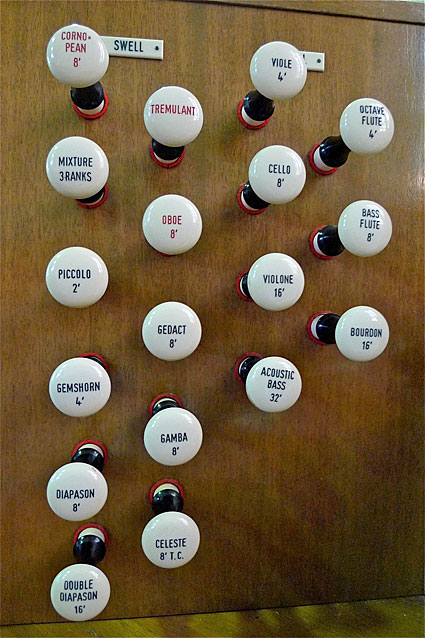
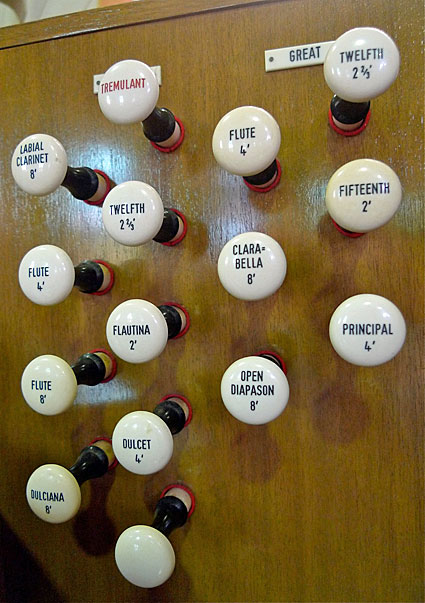
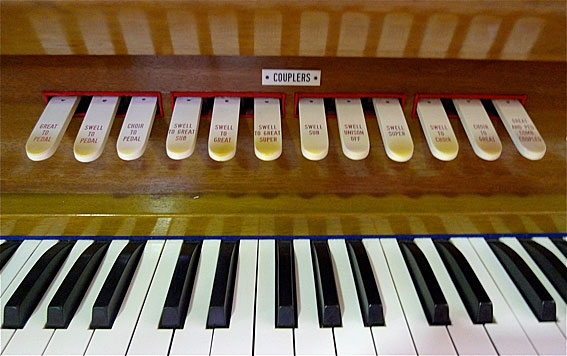

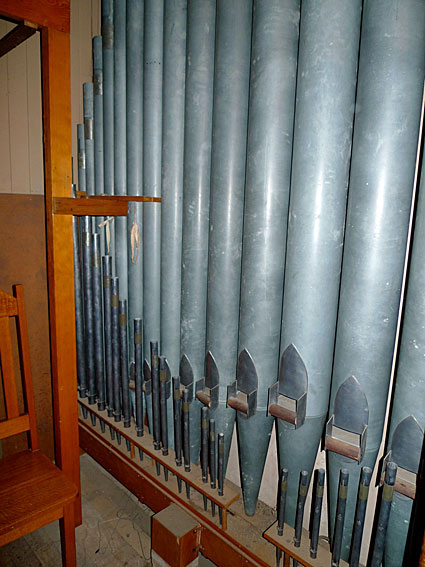
[Photographs by Trevor Bunning (August 2010)]